A Level Mathematics - Questionbank
Trigonometry explores the properties and applications of trigonometric functions, including sine, cosine, and tangent. Students study identities, solve equations, and analyze graphs in both degrees and radians. This topic is essential for understanding angles, periodic behavior, and their applications in geometry and advanced mathematics.
Question 1
a. Given that `costheta=4/5` and that `θ` is acute, find the exact value of:
`frac{1-sin^2theta}{costheta}`
`frac{3-sintheta}{3+costheta}`
b. Given that `sintheta=1/4` and that `θ` is acute, find the exact value of:
`frac{sinthetacostheta}{tantheta}`
`1/tantheta+1/sintheta`
Easy
Mark as Complete
Mark Scheme
Question 2
Find the exact value of each of the following:
a. `frac{sin^2 45°}{2+tan60°}`
b. `frac{sin^2 30°+cos^2 30°}{2sin 45°cos 45°}`
c. `1/tan frac{pi}{4}-1/cos frac{pi}{3}`
d. `frac{cos frac{pi}{3}+ tan frac{pi}{6}}{sin frac{pi}{3}}`
Easy
Mark as Complete
Mark Scheme
Question 3
Draw a diagram showing the quadrant in which the rotating line OP lies for each of the following angles. On each diagram, indicate clearly the direction of rotation and state the acute angle that the line OP makes with the x-axis.
a. `-150°`
b. `frac{13pi}{9}`
Easy
Mark as Complete
Mark Scheme
Question 4
Given that `sintheta=2/5` and that `θ` is obtuse, find the value of:
a. `costheta`
b. `tantheta`
Easy
Mark as Complete
Mark Scheme
Question 5
Given that `tantheta=-5/12` and that `180°<=theta<=360°`, find the value of:
a. `sintheta`
b. `costheta`
Easy
Mark as Complete
Mark Scheme
Question 6
a. Sketch the graph of `y=2sinx` for `-pi<=x<=pi`. The straight line `y=kx` intersects this curve at the maximum point.
b. Find the value of `k`. Give your answer in terms of `pi`.
c. State the coordinates of the other points where the line intersects the curve.
Easy
Mark as Complete
Mark Scheme
Question 7
The graph of `y=sinx` is reflected in the line `x=pi` and then in the line `y=1`.
Find the equation of the resulting function.
Easy
Mark as Complete
Mark Scheme
Question 8
The function `f(x)=5-2sinx` is defined for the domain `pi/2<=x<=p`.
a. Find the largest value of `p` for which `f` has an inverse.
b. For this value of `p`, find `f^-1(x)` and state the domain of `f^-1`.
Medium
Mark as Complete
Mark Scheme
Question 9
Solve each of these equations for the given domains:
a. `2tan(x/2)+sqrt3=0` for `0°<=x<=540°`.
b. `sqrt2sin(x/3+pi/4)=1` for `0 < x < 4pi`.
Hard
Mark as Complete
Mark Scheme
Question 10
Solve each of these equations for `0 <= x <= 2pi`
a. `4tanx=3cosx`
b. `2cos^2x+5sinx=4`
Medium
Mark as Complete
Mark Scheme
Question 11
a. Given that `a=frac{1-sintheta}{2costheta}`, show that `1/a=frac{2(1+sintheta)}{costheta}`.
b. Hence, find `sintheta` and `costheta` in terms of `a`.
Medium
Mark as Complete
Mark Scheme
Question 12
a. Show that the equation `sinthetatantheta=3` can be written in the form `cos^2theta+3costheta-1=0`.
b. Hence, solve the equation `sinthetatantheta=3` for `0° <= theta <= 360°`.
Medium
Mark as Complete
Mark Scheme
Question 13
a. Prove the identity `frac{1}{1+sintheta}+frac{1}{1-sintheta}-=frac{2}{cos^2theta}`.
b. Hence, solve the equation `costheta(frac{1}{1+sintheta}+frac{1}{1-sintheta})=5` for `0° <= theta <= 360°`.
Medium
Mark as Complete
Mark Scheme
Question 14
a. Prove the identity `cos^4theta-sin^4theta-=2cos^2theta-1`.
b. Hence, solve the equation `cos^4theta-sin^4theta=1/2` for `0° <= theta <= 360°`.
Medium
Mark as Complete
Mark Scheme
Question 15
a. Show that the equation `frac{tanx+cosx}{tanx-cosx}=k`, where `k` is a constant, can be expressed as `(k+1)sin^2x+(k-1)sinx-(k+1)=0`.
b. Hence solve the equation `frac{tanx+cosx}{tanx-cosx}=4` for `0° <= x <= 360°`.
Hard
Mark as Complete
Mark Scheme
Question 16
a. Prove the identity `frac{1+sinx}{1-sinx}-frac{1-sinx}{1+sinx}-=frac{4tanx}{cosx}`.
b. Hence solve the equation `frac{1+sinx}{1-sinx}-frac{1-sinx}{1+sinx}=8tanx` for `0 <= x <= 1/2 pi`.
Hard
Mark as Complete
Mark Scheme
Question 17
a. Prove the identity `frac{1-2sin^2theta}{1-sin^2theta}-=1-tan^2theta`.
b. Hence solve the equation `frac{1-2sin^2theta}{1-sin^2theta}=2tan^4theta` for `0° <= theta <= 180°`.
Medium
Mark as Complete
Mark Scheme
Question 18
a. Show that `frac{sintheta+2costheta}{costheta-2sintheta}-frac{sintheta-2costheta}{costheta+2sintheta}=frac{4}{5cos^2theta-4}`.
b. Hence solve the equation `frac{sintheta+2costheta}{costheta-2sintheta}-frac{sintheta-2costheta}{costheta+2sintheta}=5` for `0° < theta < 180°`.
Hard
Mark as Complete
Mark Scheme
Question 19
a. Prove the identity `frac{sin^3theta}{sintheta-1}-frac{sin^2theta}{1+sintheta}-=-tan^2theta(1+sin^2theta)`.
b. Hence solve the equation `frac{sin^3theta}{sintheta-1}-frac{sin^2theta}{1+sintheta}=tan^2theta(1-sin^2theta)` for `0 < theta < 2pi`.
Hard
Mark as Complete
Mark Scheme
Question 20
a.
i. By first expanding `(costheta+sintheta)^2`, find the three solutions of the equation `(costheta+sintheta)^2=1` for `0 <= theta <= pi`.
ii. Hence verify that the only solutions of the equation `costheta+sintheta=1` for are `0` and for `1/2pi`.
b. Prove the identity `frac{sintheta}{costheta+sintheta}+frac{1-costheta}{costheta-sintheta}-=frac{costheta+sintheta-1}{1-2sin^2theta}`.
c. Using the results of (a) (ii) and (b), solve the equation `frac{sintheta}{costheta+sintheta}+frac{1-costheta}{costheta-sintheta}=2(costheta+sintheta-1)` for `0 <= theta <= pi`.
Hard
Mark as Complete
Mark Scheme
Question 1
a. Given that `costheta=4/5` and that `θ` is acute, find the exact value of:
`frac{1-sin^2theta}{costheta}`
`frac{3-sintheta}{3+costheta}`
b. Given that `sintheta=1/4` and that `θ` is acute, find the exact value of:
`frac{sinthetacostheta}{tantheta}`
`1/tantheta+1/sintheta`
a.
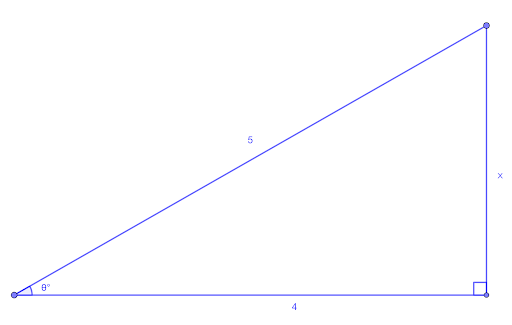
Use the triangle shown and Pythagoras’ theorem
`x=sqrt(5^2-4^2)=3`
`costheta=4/5`
`sintheta=3/5`
`frac{1-sin^2theta}{costheta}=frac{cos^2theta}{costheta}=costheta=4/5` (as `sin^2x+cos^2x=1`)
`frac{3-sintheta}{3+costheta}=frac{15/5-3/5}{15/5+4/5}=frac{12/5}{19/5}=12/19`
b.
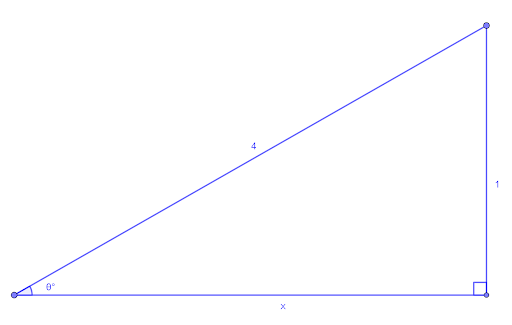
Use the triangle shown and Pythagoras’ theorem
`x=sqrt(4^2-1^2)=sqrt15`
`costheta=sqrt15/4`
`sintheta=1/4`
`tantheta=sintheta/costheta`
`frac{sinthetacostheta}{tantheta}=frac{sinthetacostheta}{sintheta/costheta}=cos^2theta=(costheta)^2=(sqrt15/4)^2=15/16`
`1/tantheta+1/sintheta=1/frac{sintheta}{costheta}+1/sintheta=frac{costheta+1}{sintheta}`
`=frac{sqrt15/4+1}{1/4}=frac{frac{sqrt15+4}{4}}{1/4}`
`=sqrt15+4`
Question 2
Find the exact value of each of the following:
a. `frac{sin^2 45°}{2+tan60°}`
b. `frac{sin^2 30°+cos^2 30°}{2sin 45°cos 45°}`
c. `1/tan frac{pi}{4}-1/cos frac{pi}{3}`
d. `frac{cos frac{pi}{3}+ tan frac{pi}{6}}{sin frac{pi}{3}}`
a.
`frac{sin^2 45°}{2+tan 60°}`
`=frac{(1/sqrt2)^2}{2+sqrt3}=frac{1/2}{frac{2+sqrt3}{1}}=frac{1}{4+2sqrt3}`
`=frac{1}{4+2sqrt3}xxfrac{4-2sqrt3}{4-2sqrt3}=frac{4-2sqrt3}{4^2-(2sqrt3)^2` (as `(a+b)(a-b)=a^2-b^2`)
`=frac{4-2sqrt3}{16-12}=frac{4-2sqrt3}{4}=frac{2-sqrt3}{2}`
b. `frac{sin^2 30°+cos^2 30°}{2sin 45°cos 45°}`
`=frac{1}{2xx1/sqrt2xx1/sqrt2}=1` (as `sin^2x+cos^2x=1`)
c. `1/tan frac{pi}{4}-1/cos frac{pi}{3}`
`=1/1-frac{1}{1/2}=1-2=-1`
d. `frac{cos frac{pi}{3}+ tan frac{pi}{6}}{sin frac{pi}{3}}`
`frac{1/2+1/sqrt3}{sqrt3/2}=frac{frac{sqrt3+2}{2sqrt3}}{sqrt3/2}`
`=frac{2sqrt3+4}{6}=frac{sqrt3+2}{3}`
Question 3
Draw a diagram showing the quadrant in which the rotating line OP lies for each of the following angles. On each diagram, indicate clearly the direction of rotation and state the acute angle that the line OP makes with the x-axis.
a. `-150°`
b. `frac{13pi}{9}`
a. `-150°` is a clockwise rotation
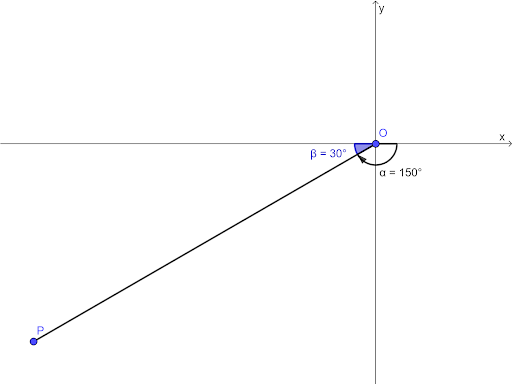
Acute angle made with x-axis `=30°`
b. `frac{13pi}{9}` is an anticlockwise rotation
`frac{13xx180°}{9}=13xx20°=260°`
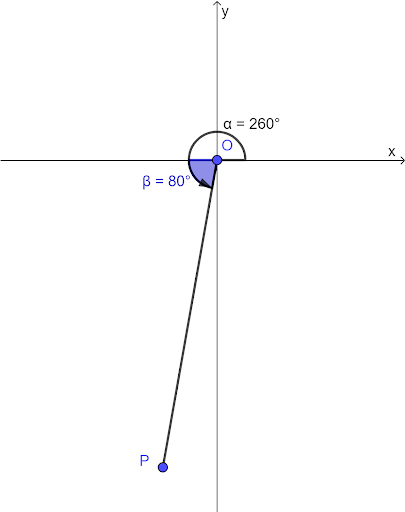
`frac{80°xxpi}{180°}=frac{4pi}{9}`
Acute angle made with x-axis `=frac{4pi}{9}`
Question 4
Given that `sintheta=2/5` and that `θ` is obtuse, find the value of:
a. `costheta`
b. `tantheta`
The second quadrant `90° (`θ` is obtuse)
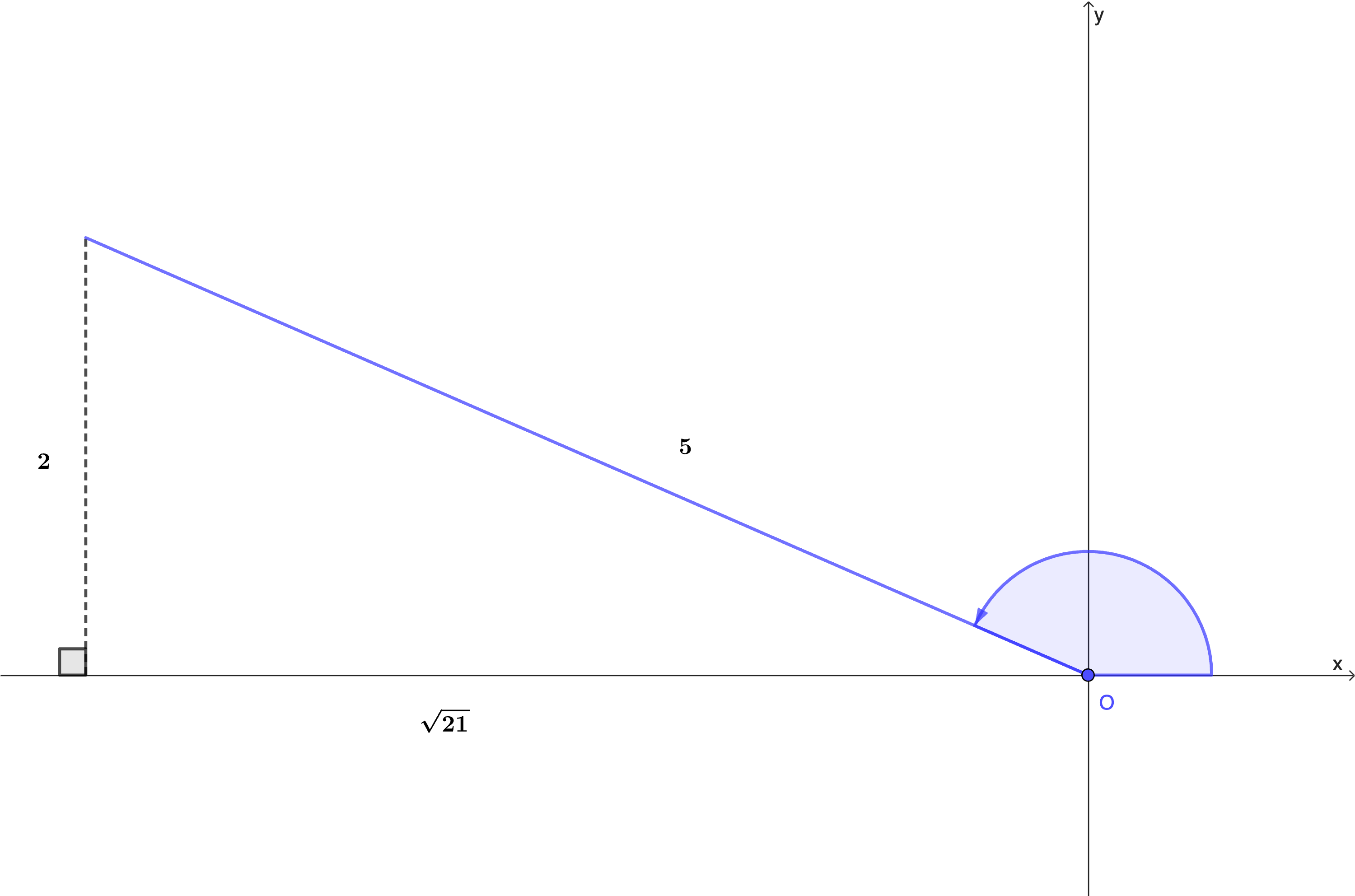
Using Pythagoras
`x=sqrt(5^2-2^2)=+-sqrt21`
`x=-sqrt21` (as `x<0`)
a. `costheta=frac{-sqrt21}{5}`
b. `tantheta=2/-sqrt21=-frac{2sqrt21}{21}`
Question 5
Given that `tantheta=-5/12` and that `180°<=theta<=360°`, find the value of:
a. `sintheta`
b. `costheta`
`180°<=theta<=360°` are the quadrants III and IV
tan is positive in the quadrant III, so `tantheta=-5/12` belongs to the quadrant IV
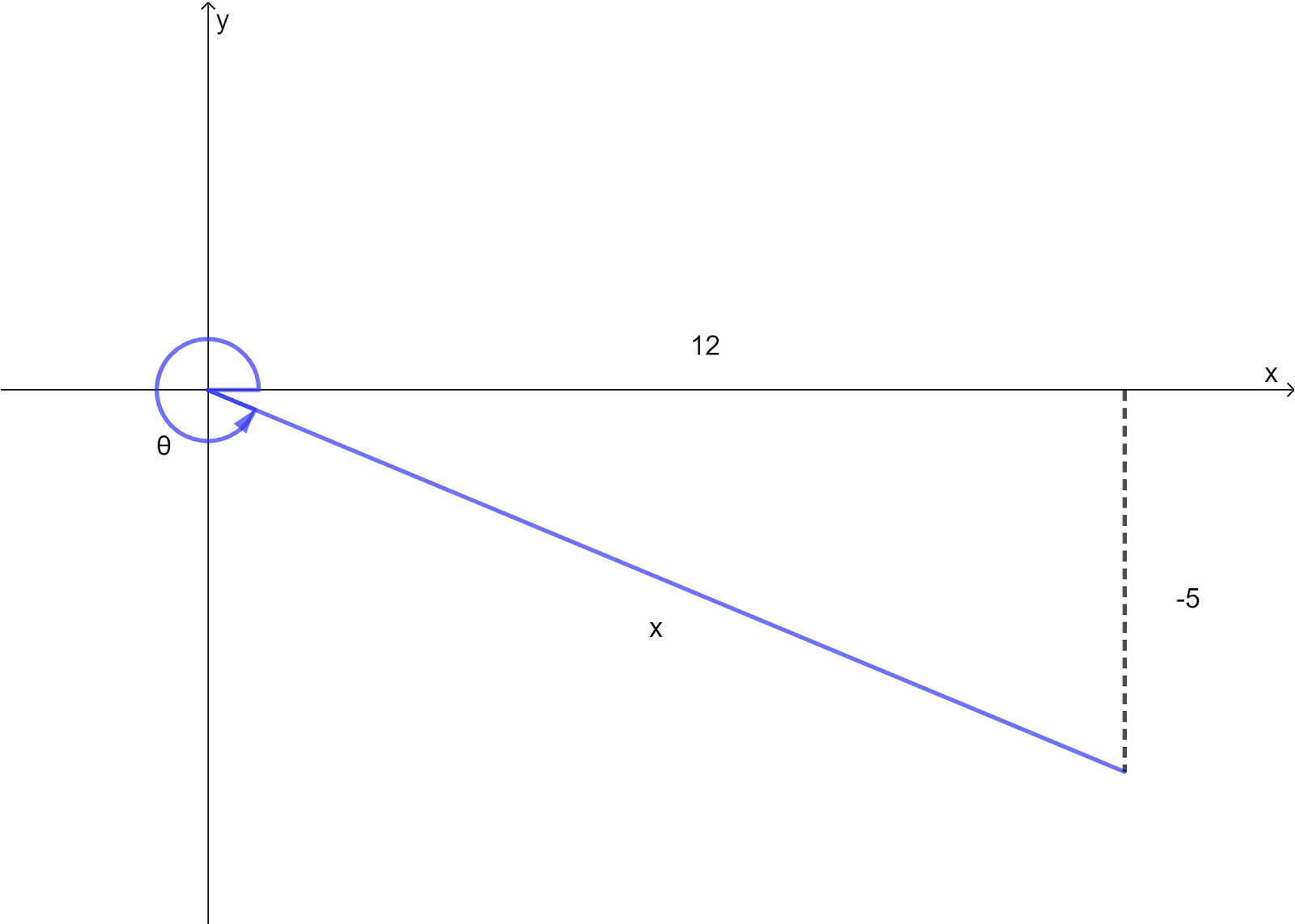
`x^2=12^2+(-5)^2`
`x=+-sqrt169`
`x=13` (`x>0` by definition)
a. `sintheta=-frac{5}{13}`
b. `costheta=12/13`
Question 6
a. Sketch the graph of `y=2sinx` for `-pi<=x<=pi`. The straight line `y=kx` intersects this curve at the maximum point.
b. Find the value of `k`. Give your answer in terms of `pi`.
c. State the coordinates of the other points where the line intersects the curve.
a. The graph of `y=sinx` (amplitude `=1`, period `= 2 π`) is transformed to the graph of `y=2sinx` by stretch factor `2`, parallel to the y-axis
All y-coordinates of the original graph are multiplied by `2`
The maximum turning point on `y=sinx` for `-pi<=x<=pi` is at `(pi/2,1)`
The maximum turning point on `y=2sinx` for `-pi<=x<=pi` is at `(pi/2,2)`
b. The straight line `y=kx` intersect the graph at the maximum point `(pi/2,2)`
Substitute `(pi/2,2)` into `y=kx`
`2=kxxpi/2`
`k=4/pi`
c. The straight line `y=4/pix` intersects the graph at `(-pi/2,-2)` using symmetry
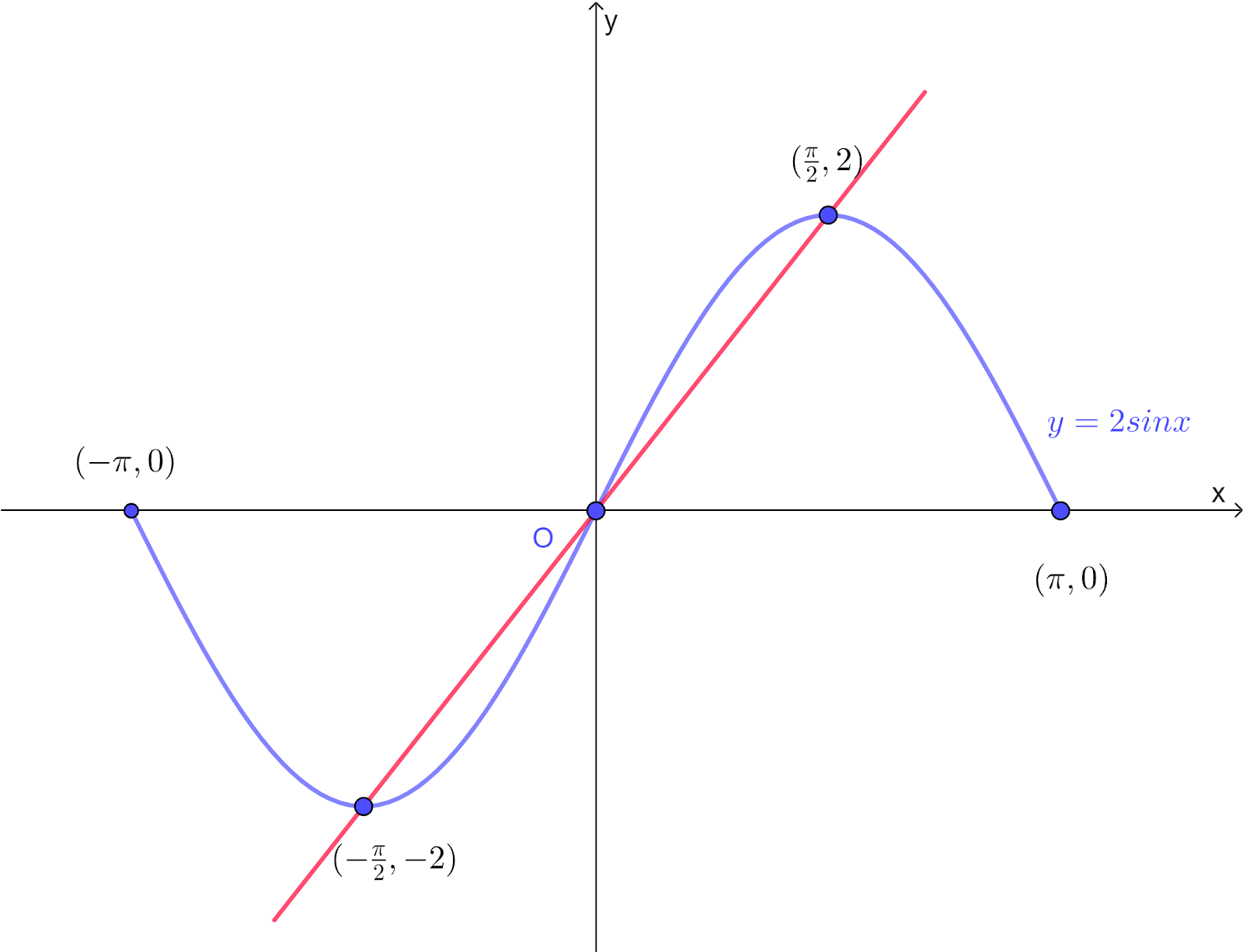
Question 7
The graph of `y=sinx` is reflected in the line `x=pi` and then in the line `y=1`.
Find the equation of the resulting function.
For `y=sinx` reflected in `x=pi`
Equation of the resulting function
`y=-sinx`
For `y=-sinx` reflected in `y=1`
Equation of the resulting function
`y=2+sinx`
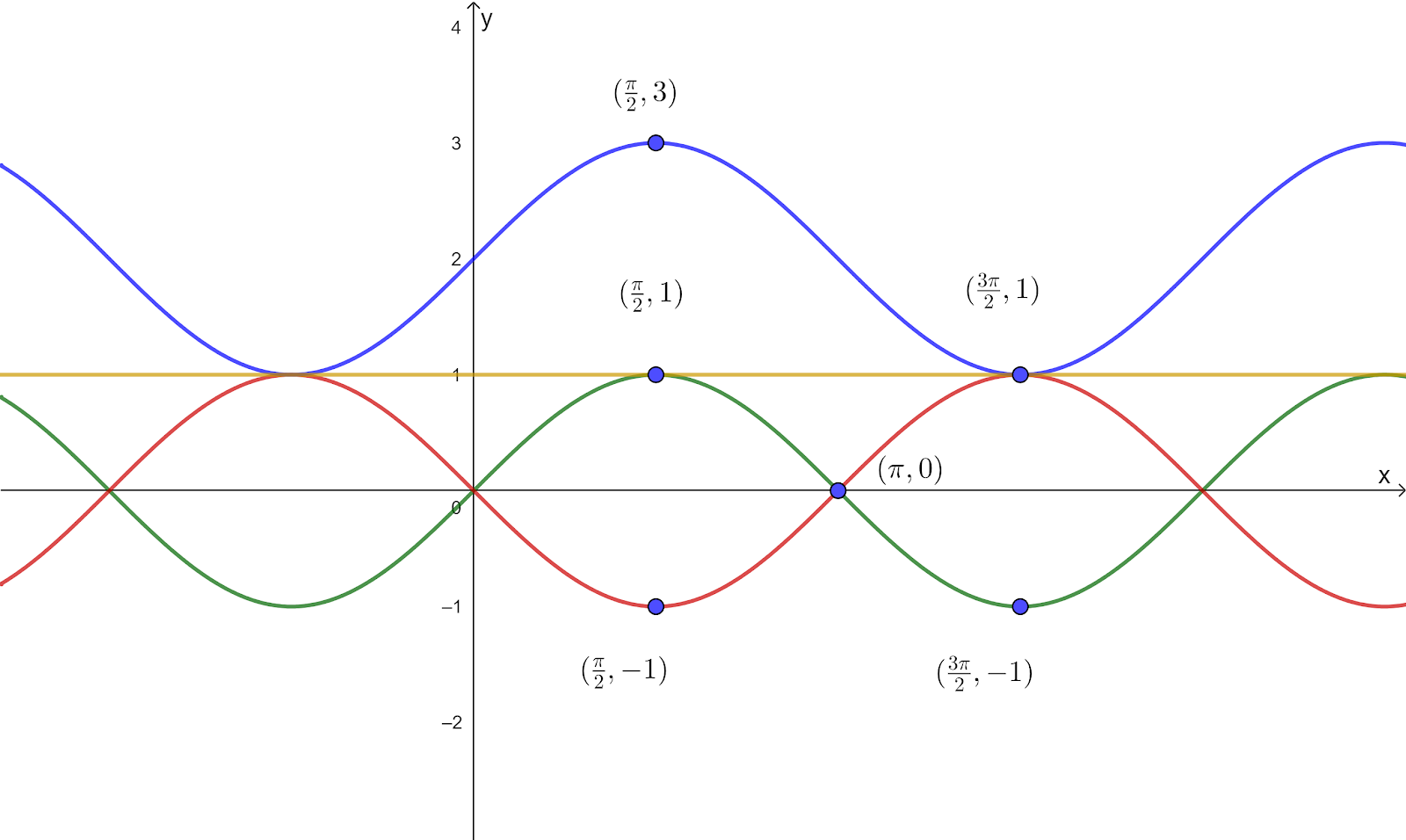
Question 8
The function `f(x)=5-2sinx` is defined for the domain `pi/2<=x<=p`.
a. Find the largest value of `p` for which `f` has an inverse.
b. For this value of `p`, find `f^-1(x)` and state the domain of `f^-1`.
a. The graph of `f(x)=sinx` is transformed to the graph of `f(x)=5-2sinx` by
+ a vertical stretch factor `2` (domain: `pi/2<=x<=p`, range: `-2<=x<=2`), followed by
+ a reflection in the x-axis (domain: `pi/2<=x<=p`, range: `-2<=x<=2`), followed by
+ a translation by the vector `((0),(5))` (domain: `pi/2<=x<=p`, range: `3<=f(x)<=7`)
For the domain `pi/2<=x`, the sketch of `f(x)=5-2sinx`
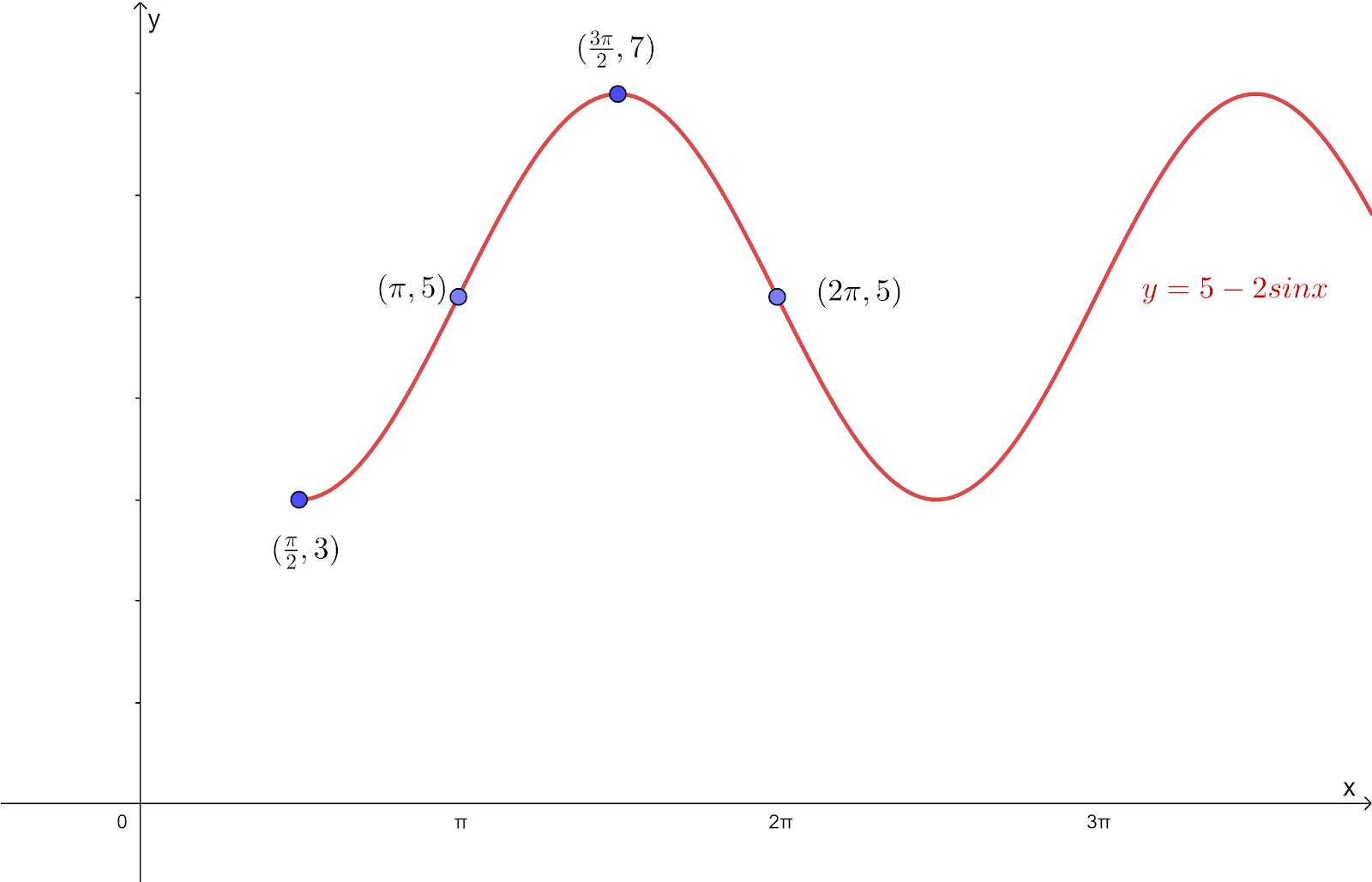
Function `f` has an inverse only if it is one to one
The maximum value of `x` from the graph is `frac{3pi}{2}`
Then `p = frac{3pi}{2}`
b. `f(x)=5-2sinx`
Write the function in terms of `y`
`y=5-2sinx`
Interchange the `x` and `y` variables
`x=5-2siny`
Rearrange to make `y` the subject
`2siny=5-x`
`siny=frac{5-x}{2}`
`y=sin^-1(frac{5-x}{2})`
Final solution
`f^-1(x)=sin^-1(frac{5-x}{2})`
The range of `f` is `3<=f(x)<=7` so the domain of `f^-1` is `3<=x<=7`
Question 9
Solve each of these equations for the given domains:
a. `2tan(x/2)+sqrt3=0` for `0°<=x<=540°`.
b. `sqrt2sin(x/3+pi/4)=1` for `0 < x < 4pi`.
a. Let `A=x/2`
`2tanA+sqrt3=0`
`tanA=-sqrt3/2`
`A=tan^-1(-sqrt3/2)`
`A=-40.89°`

Using symmetry of the curve from the sketch
The first value
`180°-40.89°=139.11°`
The second value
`360°-40.89°=319.11°`
Substitute `139.11°` into `A=x/2`
`x=2A=2xx139.11°=278.22°`
Substitute `319.11°` into `A=x/2`
`x=2A=2xx319.11°=638.22°` (out of range `0°<=x<=540°`)
Then `x=278.2°` (correct to 1 decimal place)
b. Let `A=x/3+pi/4`
`sqrt2sinA=1`
`sinA=1/sqrt2`
`A=sin^-1(1/sqrt2)`
`A=pi/4`

Using symmetry of the curve from the sketch
The first value
`0+pi/4=pi/4`
The second value
`pi-pi/4=frac{3pi}{4}`
Substitute `pi/4` into `A=x/3+pi/4`
`x/3=0`
`x=0` (out of range `0 < x < 4pi`)
Substitute `frac{3pi}[4}` into `A=x/3+pi/4`
`x/3=pi/2`
`x=frac{3pi}{2}`
Then `x=frac{3pi}[2}`
Question 10
Solve each of these equations for `0 <= x <= 2pi`
a. `4tanx=3cosx`
b. `2cos^2x+5sinx=4`
a. `4tanx=3cosx`
`4sinx/cosx=3cosx`
`4sinx=3cos^2x`
`4sinx=3(1-sin^2x)` (as `sin^2x+cos^2x=1`)
`4sinx=3-3sin^2x`
`3sin^2x+4sinx-3=0`
Let `y=sinx`
`3y^2+4y-3=0`
Using quadratic formula `y=frac{-b+-sqrt(b^2-4ac)}{2a}`
`y=frac{-4+-sqrt(4^2-4(3)(-3))}{2(3)}`
`y=frac{-4+-sqrt52}{6}`
`sinx=frac{-4+sqrt52}{6}` or `sinx=frac{-4-sqrt52}{6}`
`sinx=0.53518...` or `sinx=-1.8685`
Then `sinx=0.53518` (as `-1 <= sinx <=1`)
`x=0.5647` radians or `x=pi-0.5647=2.576` radians
b. `2cos^2x+5sinx=4`
`2(1-sin^2x)+5sinx=4` (as `sin^2x+cos^2x=1`)
`2-2sin^2x+5sinx-4=0`
`2sin^2x-5sinx+2=0`
`(2sinx-1)(sinx-2)=0`
`2sinx-1=0` or `sinx-2=0`
`sinx=1/2` or `sinx=2`
Then `sinx=1/2` (as `-1 <= sinx <= 1)`)
`x=pi/6` radians or `x=pi-pi/6=frac{5pi}{6}` radians
Question 11
a. Given that `a=frac{1-sintheta}{2costheta}`, show that `1/a=frac{2(1+sintheta)}{costheta}`.
b. Hence, find `sintheta` and `costheta` in terms of `a`.
a. `a=frac{1-sintheta}{2costheta}`
Multiply by `2costheta`
`a(2costheta)=1-sintheta`
Divide by `a`
`2costheta=frac{1-sintheta}{a}`
Divide by `1-sintheta`
`frac{2costheta}{1-sintheta}=1/a`
Multiply the left-hand side by `1+sintheta`
`frac{2costheta(1+sintheta)}{(1-sintheta)(1+sintheta)}=1/a`
`frac{2costheta(1+sintheta)}{1-sin^2theta)=1/a` (as `(a+b)(a-b)=a^2-b^2`)
`frac{2costheta(1+sintheta)}{cos^2theta}=1/a` (as `sin^2theta+cos^2theta=1`)
Divide the left-hand side by `costheta`
`frac{2(1+sintheta)}{costheta}=1/a`
b. For `a(2costheta)=1-sintheta` (from part a)
`costheta=frac{1-sintheta}{2a}` (1)
For `1/a=frac{2(1+sintheta)}{costheta}`
`frac{costheta}{a}=2(1+sintheta)`
`costheta=2a(1+sintheta)` (2)
Solve (1) and (2)
`frac{1-sintheta}{2a}=2a(1+sintheta)`
`1-sintheta=2a(2a)(1+sintheta)`
`1-sintheta=4a^2+4a^2sintheta`
`1-4a^2=sintheta+4a^2sintheta`
`1-4a^2=sintheta(1+4a^2)`
`sintheta=frac{1-4a^2}{1+4a^2}`
For `a(2costheta)=1-sintheta` (from part a)
`sintheta=1-2acostheta` (3)
For (2)
`costheta=2a+2asintheta`
`costheta-2a=2asinntheta`
`sintheta=frac{costheta-2a}{2a}` (4)
Solve (3) and (4)
`1-2acostheta=frac{costheta-2a}{2a}`
`2a(1-2acostheta)=costheta-2a`
`2a-2a(2a)costheta=costheta-2a`
`2a+2a=costheta+4a^2costheta`
`4a=costheta(1+4a^2)`
`costheta=frac{4a}{1+4a^2}`
Question 12
a. Show that the equation `sinthetatantheta=3` can be written in the form `cos^2theta+3costheta-1=0`.
b. Hence, solve the equation `sinthetatantheta=3` for `0° <= theta <= 360°`.
a. For `sinthetatantheta=3`
`sinthetaxxfrac{sintheta}{costheta}=3` (as `tantheta=sintheta/costheta`)
`sin^2theta/costheta=3`
`sin^2theta=3costheta`
`1-cos^2theta=3costheta` (as `sin^2theta+cos^2theta=1`)
`cos^2theta+3costheta-1=0`
b. Let `y=costheta`
`y^2+3y-1=0`
Using quadratic formula `y=frac{-b+-sqrt(b^2-4ac)}{2a}`
`y=frac{-3+-sqrt(3^2-4(1)(-1))}{2(1)}`
`y=frac{-3+-sqrt13}{2}`
`costheta=frac{-3+sqrt13}{2}` or `costheta=frac{-3-sqrt13}{2}`
`costheta=0.3027` or `costheta=-3.3027`
Then `costheta=0.3027` (as `-1 <= costheta <=1`)
`theta=72.4°` or `theta=360°-72.4°=287.6°`
Question 13
a. Prove the identity `frac{1}{1+sintheta}+frac{1}{1-sintheta}-=frac{2}{cos^2theta}`.
b. Hence, solve the equation `costheta(frac{1}{1+sintheta}+frac{1}{1-sintheta})=5` for `0° <= theta <= 360°`.
a. For `frac{1}{1+sintheta}+frac{1}{1-sintheta}`
Multiply by `1-sintheta`
`=frac{1-sintheta}{(1+sintheta)(1-sintheta)}+frac{1+sintheta}{(1+sintheta)(1-sintheta)}`
`=frac{1-sintheta+1+sintheta}{(1+sintheta)(1-sintheta)`
`=frac{2}{1-sin^2theta}` (as `(a+b)(a-b)=a^2-b^2`)
`=frac{2}{cos^2theta}` (as `sin^2theta+cos^2theta=1`)
Then `frac{1}{1+sintheta}+frac{1}{1-sintheta}-=frac{2}{cos^2theta}`
b. `costheta(frac{1}{1+sintheta}+frac{1}{1-sintheta})=5`
`costhetaxx2/cos^2theta=5`
`2/costheta=5`
`2=5costheta`
`costheta=2/5`
`theta=66.4°` or `theta=360°-66.4°=293.6°`
Question 14
a. Prove the identity `cos^4theta-sin^4theta-=2cos^2theta-1`.
b. Hence, solve the equation `cos^4theta-sin^4theta=1/2` for `0° <= theta <= 360°`.
a. For `cos^4theta-sin^4theta`
`=(cos^2theta-2sin^2theta)(cos^2theta+sin^2theta)` (as `(a+b)(a-b)=a^2-b^2`)
`=cos^2theta-sin^2theta` (as `sin^2theta+cos^2theta=1`)
`=cos^2theta-(1-cos^2theta)`
`=cos^2theta-1+cos^2theta`
`=2cos^2theta-1`
Then `cos^4theta-sin^4theta-=2cos^2theta-1`
b. `2cos^2theta-1=1/2`
`2cos^2theta=3/2`
`cos^2theta=3/4`
`costheta=+-sqrt(3/4)`
`costheta=sqrt3/2` or `costheta=-sqrt3/2`
`theta=30°` or `theta=360°-30°=330°` or `theta=150°` or `theta=360°-150°=210°`
Question 15
a. Show that the equation `frac{tanx+cosx}{tanx-cosx}=k`, where `k` is a constant, can be expressed as `(k+1)sin^2x+(k-1)sinx-(k+1)=0`.
b. Hence solve the equation `frac{tanx+cosx}{tanx-cosx}=4` for `0° <= x <= 360°`.
a. For `frac{tanx+cosx}{tanx-cosx}=k`
`frac{sinx/cosx+cosx}{sinx/cosx-cosx}=k` (as `tanx=sinx/cosx`)
`frac{frac{sinx+cos^2x}{cosx}}{frac{sinx-cos^2x}{cosx}}=k`
`frac{sinx+cos^2x}{sinx-cos^2x}=k`
`sinx+cos^2x=k(sinx-cos^2x)`
`sinx+1-sin^2x=k(sinx-(1-sin^2x))`
`sinx+1-sin^2x=ksinx-k+ksin^2x`
`ksin^2x+sin^2x+ksinx-sinx-k-1=0`
`(k+1)sin^2x+(k-1)sinx-(k+1)=0` (1)
b. `frac{tanx+cosx}{tanx-cosx}=4`
`k=4`
For (1)
`(4+1)sin^2x+(4-1)sinx-(4+1)=0`
`5sin^2x+3sinx-5=0`
Using quadratic formula `sinx=frac{-b+-sqrt(b^2-4ac)}{2a}`
`sinx=frac{-3+-sqrt(3^2-4(5)(-5))}{2(5)}`
`sinx=frac{-3+-sqrt109){10}`
`sinx=0.744` or `sinx=-1.344`
Then `sinx=0.744` (as `-1 <= sinx <=1`)
`x=48.1°` or `x=180°-48.1°=131.9°`
Question 16
a. Prove the identity `frac{1+sinx}{1-sinx}-frac{1-sinx}{1+sinx}-=frac{4tanx}{cosx}`.
b. Hence solve the equation `frac{1+sinx}{1-sinx}-frac{1-sinx}{1+sinx}=8tanx` for `0 <= x <= 1/2 pi`.
a. For `frac{1+sinx}{1-sinx}-frac{1-sinx}{1+sinx}`
`=frac{(1+sinx)(1+sinx)}{(1-sinx)(1+sinx)}-frac{(1-sinx)(1-sinx)}{(1-sinx)(1+sinx)}`
`=frac{(1+sinx)^2-(1-sinx)^2}{(1-sinx)(1+sinx)`
`=frac{1+2sinx+sin^2x-(1-2sinx+sin^2x)}{1-sin^2x}` (as `(a+b)(a-b)=a^2-b^2`)
`=frac{1+2sinx+sin^2x-1+2sinx-sin^2x}{1-sin^2x}`
`frac{4sinx}{1-sin^2x}`
`=frac{4sinx}{cos^2x}` (as `sin^2x+cos^2x=1`)
`=frac{4sinx}{cosxcosx}`
`=frac{4tanx}{cosx}` (as `tanx=sinx/cosx`)
Then `frac{1+sinx}{1-sinx}-frac{1-sinx}{1+sinx}-=frac{4tanx}{cosx}`
b. `frac{4tanx}{cosx}=8tanx`
`frac{4tanx}{cosx}-8tanx=0`
`4tanx(1/cosx-2)=0`
`4tanx=0` or `1/cosx-2=0`
`tanx=0` or `1/cosx=2`
`tanx=0` or `cosx=1/2`
`x=0` or `x=pi/3`
Question 17
a. Prove the identity `frac{1-2sin^2theta}{1-sin^2theta}-=1-tan^2theta`.
b. Hence solve the equation `frac{1-2sin^2theta}{1-sin^2theta}=2tan^4theta` for `0° <= theta <= 180°`.
a. For `frac{1-2sin^2theta}{1-sin^2theta}`
`=frac{1-sin^2theta-sin^2theta}{cos^2theta}` (as `sin^2theta+cos^2theta=1`)
`=frac{cos^2theta-sin^2theta}{cos^2theta}`
`=cos^2theta/cos^2theta-sin^2theta/cos^2theta`
`1-tan^2theta` (as `tantheta=sintheta/costheta`)
Then `frac{1-2sin^2theta}{1-sin^2theta}-=1-tan^2theta`
b. `1-tan^2theta=2tan^4theta`
`2tan^4theta+tan^2theta-1=0`
Using quadratic formula `tan^2theta=frac{-b+-sqrt(b^2-4ac)}{2a}`
`tan^2theta=frac{-1+-sqrt(1^2-4(2)(-1))}{2(2)}`
`tan^2theta=frac{-1+-3}{4}`
`tan^2theta=0.5` or `tan^2theta=-1`
Then `tantheta=+-sqrt0.5`
`theta=35.3°` or `theta=180°-35.3°=144.7°`
Question 18
a. Show that `frac{sintheta+2costheta}{costheta-2sintheta}-frac{sintheta-2costheta}{costheta+2sintheta}=frac{4}{5cos^2theta-4}`.
b. Hence solve the equation `frac{sintheta+2costheta}{costheta-2sintheta}-frac{sintheta-2costheta}{costheta+2sintheta}=5` for `0° < theta < 180°`.
a. For `frac{sintheta+2costheta}{costheta-2sintheta}-frac{sintheta-2costheta}{costheta+2sintheta}`
`=frac{(sintheta+2costheta)(costheta+2sintheta)}{(costheta-2sintheta)(costheta+2sintheta)}-frac{(sintheta-2costheta)(costheta-2sintheta)}{(costheta-2sintheta)(costheta+2sintheta)}`
`=frac{sinthetacostheta+2sin^2theta+2cos^2theta+4sinthetacostheta}{cos^2theta-4sin^2theta}-frac{sinthetacostheta-2sin^2theta-2cos^2theta+4sinthetacostheta}{cos^2theta-4sin^2theta}`
(as `(a+b)(a-b)=a^2-b^2`)
`=frac{5sinthetacostheta+2sin^2theta+2cos^2theta-(5sinthetacostheta-2sin^2theta-2cos^2theta)}{cos^2theta-4sin^2theta}`
`=frac{5sinthetacostheta+2sin^2theta+2cos^2theta-5sinthetacostheta+2sin^2theta+2cos^2theta}{cos^2theta-4sin^2theta}`
`=frac{4sin^2theta+4cos^2theta}{cos^2theta-4sin^2theta}`
`=frac{4(sin^2theta+cos^2theta)}{cos^2theta-4(1-cos^2theta)}` (as `sin^2theta+cos^2theta=1`)
`=frac{4(1)}{cos^2theta-4+4cos^2theta}`
`=frac{4}{5cos^2theta-4}`
Then `frac{sintheta+2costheta}{costheta-2sintheta}-frac{sintheta-2costheta}{costheta+2sintheta}=frac{4}{5cos^2theta-4}`
b. `frac{4}{5cos^2theta-4}=5`
`4=5(5cos^2theta-4)`
`4=25cos^2theta-20`
`24=25cos^2theta`
`cos^2theta=24/25`
`costheta=+-sqrt(24/25)`
`costheta=+-0.9798`
`theta=11.5°` or `theta=180°-11.5°=168.5°`
Question 19
a. Prove the identity `frac{sin^3theta}{sintheta-1}-frac{sin^2theta}{1+sintheta}-=-tan^2theta(1+sin^2theta)`.
b. Hence solve the equation `frac{sin^3theta}{sintheta-1}-frac{sin^2theta}{1+sintheta}=tan^2theta(1-sin^2theta)` for `0 < theta < 2pi`.
a. For `frac{sin^3theta}{sintheta-1}-frac{sin^2theta}{1+sintheta}`
`=frac{sin^3theta(sintheta+1)}{(sintheta-1)(sintheta+1)}-frac{sin^2theta(sintheta-1)}{(1+sintheta)(sintheta-1)}`
`=frac{sin^4theta+sin^3theta}{(sintheta-1)(sintheta+1)}-frac{sin^3theta-sin^2theta}{(sintheta-1)(sintheta+1)}`
`=frac{sin^4theta+sin^3theta-(sin^3theta-sin^2theta)}{sin^2theta-1}` (as `(a+b)(a-b)=a^2-b^2`)
`=-frac{sin^4theta+sin^3theta-sin^3theta+sin^2theta}{1-sin^2theta}`
`=-frac{sin^2theta(1+sin^2theta)}{cos^2theta}` (as `sin^2theta+cos^2theta=1`)
`=-tan^2theta(1+sin^2theta)` (as `tantheta=sintheta/costheta`)
Then `frac{sin^3theta}{sintheta-1}-frac{sin^2theta}{1+sintheta}-=-tan^2theta(1+sin^2theta)`
b. `-tan^2theta(1+sin^2theta)=tan^2theta(1-sin^2theta)`
`tan^2theta(1-sin^2theta)+tan^2theta(1+sin^2theta)=0`
`tan^2theta(1-sin^2theta+1+sin^2theta)=0`
`tan^2thetaxx2=0`
`tan^2theta=0`
`tantheta=0`
`theta=pi`
Question 20
a.
i. By first expanding `(costheta+sintheta)^2`, find the three solutions of the equation `(costheta+sintheta)^2=1` for `0 <= theta <= pi`.
ii. Hence verify that the only solutions of the equation `costheta+sintheta=1` for are `0` and for `1/2pi`.
b. Prove the identity `frac{sintheta}{costheta+sintheta}+frac{1-costheta}{costheta-sintheta}-=frac{costheta+sintheta-1}{1-2sin^2theta}`.
c. Using the results of (a) (ii) and (b), solve the equation `frac{sintheta}{costheta+sintheta}+frac{1-costheta}{costheta-sintheta}=2(costheta+sintheta-1)` for `0 <= theta <= pi`.
a.
i. For `(costheta+sintheta)^2=1`
`cos^2theta+sin^2theta+2costhetasintheta=1`
`1+2costhetasintheta=1` (as `sin^2theta+cos^2theta=1`)
`2costhetasintheta=0`
`costheta=0` or `sintheta=0`
`theta=pi/2` or `theta=-pi/2` or `theta=frac{3pi}{2}` or `theta=0` or `theta=pi`
Then `theta=pi/2` or `theta=0` or `theta=pi`
ii. For `theta=0`
`cos0+sin0=1+0=1`
For `theta=pi/2`
`cos frac{pi}{2} +sin frac{pi}{2} =0+1=1`
For `theta=pi`
`cospi+sinpi=-1+0=-1`
Then `costheta+sintheta=1` when `theta=0` and `theta=pi/2`
b. For `frac{sintheta}{costheta+sintheta}+frac{1-costheta}{costheta-sintheta}`
`=frac{sintheta(costheta-sintheta)}{(costheta+sintheta)(costheta-sintheta)}+frac{(1-costheta)(costheta+sintheta)}{(costheta+sintheta)(costheta-sintheta)}`
`frac{sinthetacostheta-sin^2theta+costheta+sintheta-cos^2theta-sinthetacostheta}{(costheta+sintheta)(costheta-sintheta)}`
`=frac{costheta+sintheta-sin^2theta-cos^2theta}{cos^2theta-sinthetacostheta+sinthetacostheta-sin^2theta}`
`=frac{costheta+sintheta-(sin^2theta+cos^2theta)}{cos^2theta-sin^2theta}`
`=frac{costheta+sintheta-1}{1-sin^2theta-sin^2theta` (as `sin^2theta+cos^2theta=1`)
`=frac{costheta+sintheta-1}{1-2sin^2theta}`
Then `frac{sintheta}{costheta+sintheta}+frac{1-costheta}{costheta-sintheta}-=frac{costheta+sintheta-1}{1-2sin^2theta}`
c. `frac[costheta+sintheta-1}{1-2sin^2theta}=2(costheta+sintheta-1)`
`costheta+sintheta-1=2(costheta+sintheta-1)(1-2sin^2theta)`
`costheta+sintheta-1-2(costheta+sintheta-1)(1-2sin^2theta)=0`
`(costheta+sintheta-1)[(1-2(1-2sin^2theta)]=0`
`(costheta+sintheta-1)(1-2+4sin^2theta)=0`
`(costheta+sintheta-1)(4sin^2theta-1)=0`
`costheta+sintheta-1=0` or `4sin^2theta-1=0`
`costheta+sintheta=1` or `4sin^2theta=1`
`theta=0` or `theta=pi/2` (part a) or `sin^2theta=1/4`
`theta=0` or `theta=pi/2` or `sintheta=1/2` or `sintheta=-1/2`
`theta=0` or `theta=pi/2` or `theta=pi/6` or `theta=frac{5pi}[6}` or `theta=-pi/6` or `theta=frac{7pi}{6}`
Then `theta=0` or `theta=pi/2` or `theta=pi/6` or `theta=frac{5pi}{6}`
Question 1
a. Given that `costheta=4/5` and that `θ` is acute, find the exact value of:
`frac{1-sin^2theta}{costheta}`
`frac{3-sintheta}{3+costheta}`
b. Given that `sintheta=1/4` and that `θ` is acute, find the exact value of:
`frac{sinthetacostheta}{tantheta}`
`1/tantheta+1/sintheta`
Question 2
Find the exact value of each of the following:
a. `frac{sin^2 45°}{2+tan60°}`
b. `frac{sin^2 30°+cos^2 30°}{2sin 45°cos 45°}`
c. `1/tan frac{pi}{4}-1/cos frac{pi}{3}`
d. `frac{cos frac{pi}{3}+ tan frac{pi}{6}}{sin frac{pi}{3}}`
Question 3
Draw a diagram showing the quadrant in which the rotating line OP lies for each of the following angles. On each diagram, indicate clearly the direction of rotation and state the acute angle that the line OP makes with the x-axis.
a. `-150°`
b. `frac{13pi}{9}`
Question 4
Given that `sintheta=2/5` and that `θ` is obtuse, find the value of:
a. `costheta`
b. `tantheta`
Question 5
Given that `tantheta=-5/12` and that `180°<=theta<=360°`, find the value of:
a. `sintheta`
b. `costheta`
Question 6
a. Sketch the graph of `y=2sinx` for `-pi<=x<=pi`. The straight line `y=kx` intersects this curve at the maximum point.
b. Find the value of `k`. Give your answer in terms of `pi`.
c. State the coordinates of the other points where the line intersects the curve.
Question 7
The graph of `y=sinx` is reflected in the line `x=pi` and then in the line `y=1`.
Find the equation of the resulting function.
Question 8
The function `f(x)=5-2sinx` is defined for the domain `pi/2<=x<=p`.
a. Find the largest value of `p` for which `f` has an inverse.
b. For this value of `p`, find `f^-1(x)` and state the domain of `f^-1`.
Question 9
Solve each of these equations for the given domains:
a. `2tan(x/2)+sqrt3=0` for `0°<=x<=540°`.
b. `sqrt2sin(x/3+pi/4)=1` for `0 < x < 4pi`.
Question 10
Solve each of these equations for `0 <= x <= 2pi`
a. `4tanx=3cosx`
b. `2cos^2x+5sinx=4`
Question 11
a. Given that `a=frac{1-sintheta}{2costheta}`, show that `1/a=frac{2(1+sintheta)}{costheta}`.
b. Hence, find `sintheta` and `costheta` in terms of `a`.
Question 12
a. Show that the equation `sinthetatantheta=3` can be written in the form `cos^2theta+3costheta-1=0`.
b. Hence, solve the equation `sinthetatantheta=3` for `0° <= theta <= 360°`.
Question 13
a. Prove the identity `frac{1}{1+sintheta}+frac{1}{1-sintheta}-=frac{2}{cos^2theta}`.
b. Hence, solve the equation `costheta(frac{1}{1+sintheta}+frac{1}{1-sintheta})=5` for `0° <= theta <= 360°`.
Question 14
a. Prove the identity `cos^4theta-sin^4theta-=2cos^2theta-1`.
b. Hence, solve the equation `cos^4theta-sin^4theta=1/2` for `0° <= theta <= 360°`.
Question 15
a. Show that the equation `frac{tanx+cosx}{tanx-cosx}=k`, where `k` is a constant, can be expressed as `(k+1)sin^2x+(k-1)sinx-(k+1)=0`.
b. Hence solve the equation `frac{tanx+cosx}{tanx-cosx}=4` for `0° <= x <= 360°`.
Question 16
a. Prove the identity `frac{1+sinx}{1-sinx}-frac{1-sinx}{1+sinx}-=frac{4tanx}{cosx}`.
b. Hence solve the equation `frac{1+sinx}{1-sinx}-frac{1-sinx}{1+sinx}=8tanx` for `0 <= x <= 1/2 pi`.
Question 17
a. Prove the identity `frac{1-2sin^2theta}{1-sin^2theta}-=1-tan^2theta`.
b. Hence solve the equation `frac{1-2sin^2theta}{1-sin^2theta}=2tan^4theta` for `0° <= theta <= 180°`.
Question 18
a. Show that `frac{sintheta+2costheta}{costheta-2sintheta}-frac{sintheta-2costheta}{costheta+2sintheta}=frac{4}{5cos^2theta-4}`.
b. Hence solve the equation `frac{sintheta+2costheta}{costheta-2sintheta}-frac{sintheta-2costheta}{costheta+2sintheta}=5` for `0° < theta < 180°`.
Question 19
a. Prove the identity `frac{sin^3theta}{sintheta-1}-frac{sin^2theta}{1+sintheta}-=-tan^2theta(1+sin^2theta)`.
b. Hence solve the equation `frac{sin^3theta}{sintheta-1}-frac{sin^2theta}{1+sintheta}=tan^2theta(1-sin^2theta)` for `0 < theta < 2pi`.
Question 20
a.
i. By first expanding `(costheta+sintheta)^2`, find the three solutions of the equation `(costheta+sintheta)^2=1` for `0 <= theta <= pi`.
ii. Hence verify that the only solutions of the equation `costheta+sintheta=1` for are `0` and for `1/2pi`.
b. Prove the identity `frac{sintheta}{costheta+sintheta}+frac{1-costheta}{costheta-sintheta}-=frac{costheta+sintheta-1}{1-2sin^2theta}`.
c. Using the results of (a) (ii) and (b), solve the equation `frac{sintheta}{costheta+sintheta}+frac{1-costheta}{costheta-sintheta}=2(costheta+sintheta-1)` for `0 <= theta <= pi`.